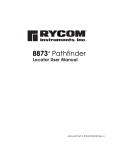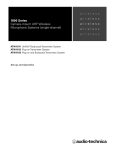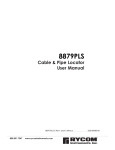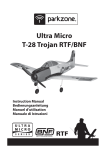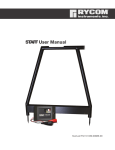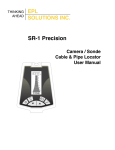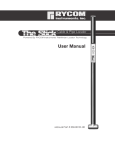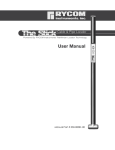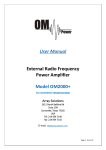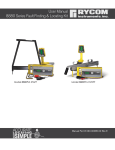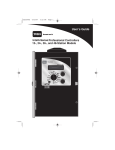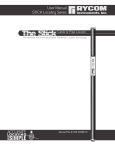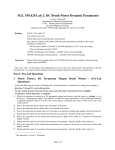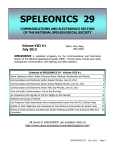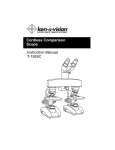Download 8856-1W Manual
Transcript
PATHFINDER SERIES Cable, Pipe and Fault Locator User’s Manual RYCOM Instruments 9351 East 59th Street Raytown, MO 64133 816.353.2100 800.851.7347 Fax: 816.353.5050 www.rycominstruments.com [email protected] now that the world is wired. where in the world is your wire? 030 00080 00 1 Table of Contents Table of Contents . . . . . . . . . . . . . . . . . . . . . . . . . . . . .1 Warranty . . . . . . . . . . . . . . . . . . . . . . . . . . . . . . . . . . .2 Introduction . . . . . . . . . . . . . . . . . . . . . . . . . . . . . . . . .3 Transmitter Controls . . . . . . . . . . . . . . . . . . . . . . . . . . .4 Transmitter Controls 1-Watt . . . . . . . . . . . . . . . . . . . . .5 Direct connect . . . . . . . . . . . . . . . . . . . . . . . . . . . . . . .6 Flexicoupler Connection Inductive Connection . . . . . . . . . . . . . . . . . . . . . . . . . .7 Blind Search Selecting Tracing Signal . . . . . . . . . . . . . . . . . . . . . . . .8 Receiver Controls . . . . . . . . . . . . . . . . . . . . . . . . . . . . .9 Locating The Cable Or Pipe . . . . . . . . . . . . . . . . . . . .10 Selecting Peak or Null Peak Locating . . . . . . . . . . . . . . . . . . . . . . . . . . . . . .11 Passive 50/60 Locating . . . . . . . . . . . . . . . . . . . . . . .12 Depth Measurement 45 Degree Angle Method (Null) Depth Measurement Straight Lift Method (Null) . . . . . .13 Depth Measurement 45 Degree Angle Method (Peak) .14 Depth Measurement Straight Lift Method (Peak) . . . . .15 Fault Locating . . . . . . . . . . . . . . . . . . . . . . . . . . . . . .16 Signal Return Ground Return Probe Ground Return Probe Insertion . . . . . . . . . . . . . . . . . .17 Spoked Wheel Return Path Ground Return Probe Fault Locating . . . . . . . . . . . . .18 Faults Beneath Paved Surfaces . . . . . . . . . . . . . . . . .19 Specifications . . . . . . . . . . . . . . . . . . . . . . . . . . . . . . .20 2 FACTORY SERVICE The RYCOM PathFinder Series was designed for dependable operation with recommended yearly adjustment or calibration. If, however, your PathFinder is not working properly, first call the factory to receive an RMA number, then return it to the factory for repair. Send it prepaid to: RYCOM Instruments, Inc. 9351 East 59th Street Raytown, Missouri 64133 USA 816.353.2100 or 800.851.7347 Fax: 816.353.5050 We will repair and ship the instrument back within 10 working days, or advise you if the instrument is unrepairable. Note: There is a minimum charge for repair and handling. When shipping your PathFinder for service be sure to include RMA number. Packing Instructions Remove all batteries, and place the unit in the original shipping carton, or equivalent sturdy container. Add packing material around all sides of the unit. Seal the shipping container with strong tape. Mark the shipping container: FRAGILE ELECTRONIC EQUIPMENT Warranty THIS INSTRUMENT IS UNDER WARRANTY FOR ONE YEAR FROM THE DATE OF DELIVERY AGAINST DEFECTS IN MATERIAL AND WORKMANSHIP (EXCEPT BATTERIES). WE WILL REPAIR OR REPLACE PRODUCTS THAT PROVE TO BE DEFECTIVE DURING WARRANTY PERIOD. THIS WARRANTY IS VOID IF, AFTER HAVING RECEIVED THE INSTRUMENT IN GOOD CONDITION, IT IS SUBJECTED TO ABUSE, UNAUTHORIZED ALTERATIONS OR CASUAL REPAIR. NO OTHER WARRANTY IS EXPRESSED OR IMPLIED. THE WARRANTY DESCRIBED IN THE PARA- GRAPH SHALL BE IN LIEU OF ANY OTHER WARRANTY, INCLUDING BUT NOT LIMITED TO, ANY IMPLIED WARRANTY OF MERCHANTABILITY OR FITNESS FOR A PARTICULAR PURPOSE. FOR CONSEQUENTIAL DAMAGES. WE ARE NOT LIABLE 3 Introduction Congratulations on the purchase of your new PathFinder Series Cable & Pipe Locator. The Path Finder Series is specially designed to detect buried CATV cables, power cables, gas and water pipes, sewer lines, telephone cables, and fiber optic cables with sheath.The 8856 and 8858 Pathfinder models are fault locator's, when used with Ground Return Probe. ! Warning The PathFinder is designed to detect the electromagnetic field emitted from buried metallic utilities. There are buried cables, pipes, and utilities this instrument cannot detect. LOCATING is not an exact science. The only way to be sure of the existence, location or depth of buried utilities is to expose the utility. DISCLAIMER OF LIABILITY MANUFACTURER SHALL NOT BE LIABLE TO DISTRIBUTOR, RESELLER, OR ANY OTHER PERSON FOR ANY INCIDENTAL, INDIRECT, SPECIAL, EXEMPLARY OR CONSEQUENTIAL DAMAGES, OR INJURY OF ANY TYPE WHATSOEVER, AND CAUSED DIRECTLY OR INDIRECTLY BY PRODUCTS SOLD OR SUPPLIED BY RYCOM INSTRUMENTS. The TRANSMITTER applies a tracing signal onto a cable or pipe. The RECEIVER detects the tracing signal. You can locate the relative position of the buried pipe or cable by following the tracing signal. Part List Path Finder 8850 8856 8858 Transmitter Unit 001-00192-00 001-00194-00 001-00196-00 Receiver Unit 001-00105-01 001-00120-00 001-00132-00 1-Watt Transmitter 001-00206-00 001-00206-02 001-00206-03 Common Parts: Manual 030-00080-00 Red/Black Test Cord 151-00051-00 Ground Rod 211-00006-01 User’s Manual 030-00048-00 8 AA-size Batteries 770-00021-00 8 C-size Batteries 770-00022-00 Options: Flexicoupler 120-00166-00 Hard Clamp 100-00134-00 Prepare for Use Make sure there is no shipping damage and all the parts are included. Unpack your new PathFinder locator. Locate the battery compartment on the back of the “head” of the RECEIVER. Open the compartment using a phillips screwdriver. Install the eight Duracell “AA” batteries as marked. Locate the battery compartment inside the TRANSMITTER. Remove the battery compartment door. Install the eight Duracell “C” batteries as marked. Note: For longer battery life and reliable operation under adverse conditions, use only Duracell alkaline batteries. 4 PATHFINDER Series Transmitter Controls and Indicators Low Battery Indicator TX OUTPUT JACK OFF Frequency Selector Buttons Power On & Frequency Indicators PRESS FREQUENCY BUTTON TO TURN ON TRANSMITTER FOR INDUCTIVE MODE PLACE UNIT ON SIDE TX OUTPUT JACK The RED/BLACK CORD, Coupler and FLEXICOUPLER connect here to create a circuit on the buied utility. POWER ON AND FREQUENCEY INDICATOR When lit, the LED light indicates the TRANSMITTER is on and the frequencey. OUTPUT FREQUENCY CONTROL The 82 kHz reading indicates that the 82 kHz frequency is in use. This frequency is the higher of the two. The 82 kHz frequency is often used to locate sharp corners in cables or pipes and is capable of jumping disconnected shield bonds or grounds. The 815 Hz reading indicates that the 815 Hz frequency is in use. The 815 Hz is the lower frequency. It is less susceptible to locating errors caused by adjacent cables or pipes. Also, by using the 815 Hz frequency, the locating range is greater. 5 PATHFINDER Series 1-WATT Transmitter Controls and Indicators Output Signal Level Control Frequency Selector Buttons 8 15 H 8 2kH U T P UT N/ OFF z I/O Power On & Frequency Indicators UEN z O EQ Y O O W ER C P FR TX OUTPUT JACK Frequency & Load Rate Indicators FOR INDUCTIVE MODE PLACE UNIT ON SIDE TX OUTPUT JACK The RED/BLACK CORD, Coupler and FLEXICOUPLER connects here to create a circuit on the buried utility. TX ON A Frequency light and Output level light indicates unit is on. FREQUENCY SELECTOR The 82 kHz reading indicates that the 82 kHz frequency is in use. This frequency is the high er of the three. The 82 kHz frequency is often used to locate sharp corners in cables or pipes and is capable of jumping disconnected shield bonds or grounds. The 815 Hz reading indicates that the 815 Hz frequency is in use. The 815 Hz is the lower frequency. It is less susceptible to locating errors caused by adjacent cables or pipes. Also, by using the 815 Hz frequency, the locating range is greater. LOAD RATE INDICATOR The Frequency light flashes to indicate the output circuit impedance. When the indicator blinks 4 times per second, it is indicating a nearly short circuit. When the indicator blinks 1 time every 3 seconds, it is indicating a nearly open circuit. Note: Holding down the Power Output button for 2 Seconds will Mute the Audio Load Rate indicator. OUTPUT SIGNAL LEVEL CONTROL The OUTPUT SIGNAL LEVEL CONTROL adjusts the power output from the TRANSMITTER. The two selections include: LOW (One LED) HIGH (Two LEDS). 6 Direct Connection ! CAUTION DO NOT CONNECT TO LIVE OR ENERGIZED POWER CABLES Direct Connection is the most reliable method of signal application. This method is relatively free of interference. The greatest amount of signal strength can be achieved by this method. Low, and high frequency may be used. The far end of the utility must be grounded. Connect the RED TEST CORD to an existing ground point or an exposed metallic section of the utility . Place the GROUND ROD approximately 10 feet from this point, at an angle of 90º to the buried cable or pipe. Push the GROUND ROD into the ground 8 to 10 inches. Connect the BLACK TEST CORD to the GROUND ROD. Plug the RED/BLACK TEST CORD into the TX OUTPUT JACK. Set the FREQUENCY switch to the 815 Hz or 82 kHz. The TX ON indicator will light up. TRANSMITTER PATHFINDER TM PRESS FREQUENCY BUTTON TO TURN ON TRANSMITTER FOR INDUCTIVE MODE PLACE UNIT ON SIDE BLACK RED SYSTEM GROUND BURIED CABLE Flexicoupler Connection The optional FLEXICOUPLER and HARD COUPLER are very easy to use, and services do not have to be interrupted. The operation range is shorter than for Direct Connection methods. The tracing signal can be affected by neighboring cables and pipes. The RED/BLACK TEST CORD or the GROUND ROD are not needed for this method. Successful COUPLER operation requires an insulated conductor that is grounded on both near and far ends. Loop the FLEXICOUPLER around the cable and connect the two ends, or clamp the HARD COUPLER around the cable. It is important to connect the COUPLER around the cable needing to be traced. Connect the COUPLER around the wire closer to the outgoing cable, not near the system ground. The result will be a stronger signal. By connecting near the grounding, the range will also be shorter, and difficulty may arise determining one cable from another. Plug the COUPLER TEST CORD into the TX OUTPUT JACK. Always use the 82 kHz FREQUENCY on the RECEIVER and the TRANSMITTER. PA TH FIN D ER PRESS FREQUENCY BUTTON TO TURN ON TRANSMITTER FOR INDUCTIVE MODE PLACE UNIT ON SIDE 7 Inductive Connection This method is convenient to use, and services are not interrupted. No test cords or connections are needed. The cable or pipe must have good insulation or non-conductive coating, or the operating range will be short. Place the TRANSMITTER on the ground, as close as possible to the path of the cable or pipe. Align the ARROWS on the TRANSMITTER CONTROL PANEL at a moderate angle to the cable or pipe. Set the FREQUENCY to the 82 kHz position. First, locate the broad TRANSMITTER Null, then move toward the expected cable path while looking for the signal carried by the cable. Start tracing the path with the RECEIVER 25 feet from the TRANSMITTER. Search in the 90º zone as shown. Locate the cable or pipe, and follow the path. If the signal becomes weak, move the TRANSMITTER to a point 25 feet behind the last strong signal, and continue searching. ALIGN ARROWS ON THE TRANSMITTER PANEL WITH THE BURIED CABLE. 25 FEET PLACE ARROW ALONG CABLE PATH FOR INDUCTIVE MODE 25 FEET BURIED CABLE TRANSMITTER Blind Search The Blind Search locating techniques is used if the operator is not aware if a buried utility exists. Two people are needed for this technique. The TRANSMITTER and the RECEIVER are placed 25 feet away from each other. Each operator walks at the same speed keeping a distance of 25 feet from each other. When the receiver gives an audio response, then a buried utility is present between the RECEIVER and the TRANSMITTER. TRANSMITTER PLACE ARROW ALONG CABLE PATH FOR INDUCTIVE MODE 25 FEET DISTANCE BETWEEN TRANSMITTER AND RECEIVER RECEIVER 8 Notes on Selecting the Tracing Signal The choice of 815 Hz or 82 kHz Frequency is dependent on the conditions of the locate. The 815 Hz and 82 kHz signals each have their advantages. It is recommended to begin by using the 815 Hz signal, and continue as long as you are confident in the results. If the signal is very weak try to adjust the connection or grounding. Repeat adjustments of ground and connection point again until switching to 82 kHz. 815 Hz (lower frequency) signal is usually preferred to the 82 kHz (high frequency) signal, because it is much less susceptible to locating errors caused by nearby cables or pipes. The 815 Hz locating range is also much longer than the 82 kHz signal. The 815 Hz signal will not travel well through disconnected shield bonds or insulated pipe bushing. The 82 kHz (higher frequency) is sometimes better than the 815 Hz (lower frequency) for locating sharp corners in cables or pipes. The 82 kHz signal is also better for “jumping” disconnected shield bonds or grounds, or tracing signal may indicate one of these characteristics. The locating range is quite short for the 82 kHz signal so the TRANSMITTER must be repositioned more often during the tracing operation. This FREQUENCY is also useful for applying a signal using the FLEXICOUPLER OR THE HARD COUPLER. 9 PathFinder Series Receiver Controls SIGNAL STRENGTH LOW BATTERY INDICATOR ON/OFF/FREQUENCY SWITCH 82kHz 815Hz 50/60Hz ADJUSTS GAIN UP OR DOWN PASSIVE SWITCH 8858 ONLY PEAK ANTENNA BUBBLE LEVEL NULL ANTENNA PEAK/NULL SWITCH ACCESSORY JACK 8856/58 ONLY 10 Locating the Cable or Pipe Make sure the TRANSMITTER is connected and in the ON position. Then move approximately 15 feet away from the TRANSMITTER along the path. (Move about 25 feet for the Inductive search mode.) Hold the RECEIVER so that you can see the meter and controls easily. Make sure the RECEIVER and the TRANSMITTER FREQUENCY are both set for the same FREQUENCY, either 815 Hz (low) or 82 kHz (high). Or select the passive locating mode which does not require the transmitter (8858 only) Selecting the Peak/Null Locating Mode (8856/58 Models only) Toggle the Peak/null switch located on the bottom end of receiver to select the desired Peak or Null locating method. (Note: some units may have a P for Peak and N for Null.) 11 Peak Mode Locating Trace the path by walking away from the TRANSMITTER at a moderate pace. Move the RECEIVER to the left and right while walking, following the PEAK indications. As you trace the path, the PEAK meter reading may slowly fade as you move away from the TRANSMITTER. Increase the GAIN knob as needed to compensate for changes in level (higher or lower). One of the following may occur: a) a junction where the signal divides and goes several directions. b) a break in the cable or shield. c) a change in the depth of the cable or pipe. d) an insulated pipe fitting. e) a slack loop of cable. If you can no longer trace the path, even with the GAIN set to maximum, connect the TRANSMITTER to the far end of the path and trace back to the point where you lost the signal. Mark the straight sections of the path every few feet. Mark sharp curves, loops, and cable bundles every few inches. Sharp changes in the path cause the RECEIVER PEAK and NULL indications to behave differently than when tracing a straight path. Practice on the path that you know has turns and laterals in it. This will help you to recognize the conditions within the field. Null Mode Locating Move the RECEIVER left to right across the cable path. When the RECEIVER is directly above the cable or pipe, a NULL (lowest meter reading and lowest audio tone) will occur. When moving the RECEIVER to left or right of the NULL point, the meter reading will rise to a maximum point(PEAK). The audio tone will also be at its highest pitch. When the RECEIVER is moved beyond the PEAK, the meter will begin to fade. Trace the path by walking away from the TRANSMITTER at a moderate pace. Move the RECEIVER to the left and right when walking, following the NULL indications. As you trace the path, the PEAK meter reading may slowly fade as you move away from the TRANSMITTER. Increase the GAIN knob as needed to compensate for changes in signal level. If the PEAK meter readings suddenly changes in level (higher or lower), one of the following may have occurred: a) a junction where the signal divides and goes several directions. b) a break in the cable or shield. c) a change in the depth of the cable or pipe. d) an insulated pipe fitting. e) a slack loop of cable. If you can no longer trace the path, even with the GAIN control set to maximum, connect the TRANSMITTER to the far end of the path, and begin tracing the path back. Mark the straight section of the path every few feet. Mark sharp curves, loops, and cable bundles every few inches. Sharp changes in the path causes the RECEIVER PEAK and NULL indicators to behave differently than when tracing a straight path. Practice on the path that you know has turns and laterals in it. This will help in recognizing the conditions within the field. 12 Passive 50/60 Hz Locating (8858 Receiver only) The 8858 RECEIVER is capable of locating power utility frequencies. This MODE is useful for locating underground primary and secondary power utilities. In certain circumstances, this MODE will also locate water pipes, sewer lines, cable television, and telephone. The reason is that common electrical grounds are sometimes found among these various utilities. Select the 50/60~ (Hz) frequency on the RECEIVER in the PEAK mode. Hold the switch down on the bottom of the receiver while locating in this mode. This method is useful because of its speed and convenience. Start at a known reference point and keep in mind that other conductors in the area may produce this same locating signal. The TRANSMITTER is not required to locate in this mode. Depth Measurement 45º Angle Method (Nulling Unit) The only way to be sure of the depth of a utility is to expose the utility. Move to the location you want to measure depth. Stay at least 15 feet away from the TRANSMITTER. Move the RECEIVER left to right across the path until the cable is located. Mark the path on the ground as precisely as possible using the Null Method. Place the RECEIVER on the ground with the meter facing up. Position the unit so that the BUBBLE LEVEL on top of the meter is centered (45º). Pull the RECEIVER away from the cable path (at 90º to the cable path) keeping the BUBBLE LEVEL centered. When the receiver indicates a NULL reading, mark the location of the receiver’s foot. The distance between the RECEIVER and the cable path is the depth of the pipe or cable. A false depth reading may be caused by nearby buried metallic objects, such as a second cable, pipe, sewer, fence or railroad track. Confirm the depth measurement by repeating the above steps on the opposite side of the pipe or cable. A variance greater than 5 inches in depth measurement may indicate the presence of additional buried cables, pipes or other objects. 13 Depth Measurement Straight Lift Method (Nulling Unit) Move to the location where you want to measure the depth of the buried cable or pipe. You must stay at least 15 ft away from the TRANSMITTER. Next, place the RECEIVER on it’s side on the ground. Without moving the RECEIVER, adjust the SENSITIVITY control for a METER READING of 8. 82kHz 815Hz 82kHz 815Hz Then lift the RECEIVER straight up without twisting, turning, or drifting to the left or right of the path. Continue to lift the RECEIVER until a new METER READING of 6.5 is found. If you are unable to reach a METER READING of 6.5 by using the straight lift method, use the 45 degree triangular method to determine the depth measurement of the utility. The height of the heel of the RECEIVER above the ground is the depth of the cable. 14 Depth Measurement 45º Angle Method (Peaking Unit) Move to the spot where you want to measure the depth of the underground utility. Stay at least 15 ft away from the TRANSMITTER. Start by swinging the RECEIVER across the path until the RECEIVER indicates a peak METER READING. Then, adjust the SENSITIVITY control for a peak METER READING of just below 8. Mark the path on the ground as precisely as possible. Position the RECEIVER on the ground as shown. Adjust the SENSITIVITY control for a METER READING of 8. Move the RECEIVER slowly away from the path at a 90 degree angle until the METER READING drops to 7. Mark this point. Move the RECEIVER back towards the cable until the METER peaks at 8. Next, move to the far side of the cable until the METER READING drops to 7. Measure the distance between the two far RECEIVERS (peak 7’s). The distance between these points is the approximate depth of the pipe or cable. A false location can be caused by having nearby buried metallic objects, such as a second cable or pipe, sewer, fence, or railroad track. 82kHz 815Hz 82kHz 815Hz 82kHz 815Hz 15 Depth Measurement Lift Method (Peaking Unit) Move to the location where you want to measure the depth of the buried utility. You must stay at least 15 ft away from the TRANSMITTER. Begin by placing the RECEIVER on the ground over the buried cable or pipe. Without moving the RECEIVER, adjust the SENSITIVITY control for a METER READING of 8. Start by lifting the RECEIVER straight up without twisting, turning, or drifting to the left or right of the path. Continue to lift the RECEIVER until a new METER READING of 5 is found. If you are unable to reach a METER READING of 5 by using the straight lift method, use the 45 degree triangular method to determine the depth measurement of the utility. The height of the RECEIVER ANTENNA above the ground is the depth of the cable. 82kHz 815Hz 82kHz 815Hz 16 Fault Locating with the PathFinder Fault locating determines the position of an insulated break on an underground conductor. In the case of an insulation fault, some of the signal will return to the TRANSMITTER attached to the GROUND ROD through a break in the insulation. NEAR ACCESS POINT FAR ACCESS POINT PA TH FIN D ER PRESS FREQUENCY BUTTON TO TURN ON TRANSMITTER FOR INDUCTIVE M ODE PLACE UNIT ON SIDE BLACK RED B A EARTH FAULT BURIED CABLE RETURN PATH THROUGH SOIL Signal Return Through an Insulated Fault It is generally a good idea to locate the conductor path before attempting to fault locate. If, during the path locate, an unusual amount of signal loss occurs, a part of the signal has escaped to ground in the last several feet. Note: Signal would go to ground at a grounded splice point, which would act as a fault during the path and fault locate. Once the path is determined and there is a general area where a fault is expected, additional current can be forced to flow through the fault by disconnecting and isolating the far access point. If the current has no path to ground at the far access point, it will be forced to seek ground at the fault. This will increase the current in the soil at the fault and detection of the fault. Ground Return Probe To begin fault locating, open the GROUND RETURN PROBE (GRP) and attach the RECEIVER as shown below. Plug the GROUND RETURN PROBE CORD into the GRP handle with the straight connection. The GROUND RETURN PROBE is collapsible for easy transport and storage. USE CAUTION WHEN OPENING AND CLOSING THE GRP 82kH z 815H z 17 Ground Return Probe Insertion Circuitry between the ground spikes provides a path for current in the soil returning to the GROUND ROD. The current enters one spike of the GROUND RETURN PROBE and exits the other spike. The GRP should be inserted into the soil with consistent force and depth. 82kHz 815Hz 82kHz 815Hz The current in the soil spreads out from the fault like the spokes of a wheel. The current is highly concentrated in the soil near the fault as it begins its return, and near the GROUND ROD as it finishes its return. Notice that the current is widely dispersed in the soil between the fault and the GROUND ROD. Spoked Wheel Return Path 18 Ground Return Probe Fault Locating The 8856 and 8858 RECEIVER measures the amount of current that is flowing through the GROUND RETURN PROBE (GRP). The RECEIVER must be on the 815Hz frequency when using the GROUND RETURN PROBE. When you walk the path using the GRP, you drop the probe every three or four steps. As you near an area of high current concentration in the soil, the RECEIVER will record the high METER READINGS (peak). You will find it necessary to reduce the RECEIVER sensitivity by adjusting the GAIN CONTROL. Once the signal starts to increase, you should slow your pace. Begin covering smaller segments of the ground to avoid passing over the fault. The RECEIVER will continue to record the peak current METER READINGS until one spike of the GRP passes over the fault. When the spike passes over the fault, the current decreases and produces a null METER READING. The fault then lies between the two GRP spikes. If you move the GRP over too far, the RECEIVER will then produce a peak METER READING. NOTE: The proper GAIN SETTING Is essential in locating the fault. Begin at a METER setting between 2 and 4. Adjustments might have to be made depending on the conditions. PRESSFREQUENCY BUTTON TOTURN ONTRANSMITTER FOR INDUCTIVE MODE PLACE UNIT ON SIDE 19 Faults Beneath Paved Surfaces A potential problem could exist if a fault should lie beneath a paved surface. In this case, the GROUND RETURN PROBE will be used in the dirt at the side of the paved area. Since the return current in the soil begins its return from the fault - like the spokes of a wheel laying on the ground - equal amounts of current will enter the GRP if it is placed on the ground and positioned broadside to the fault. A NULL will be recorded when the exact broadside is accomplished. The GRP adjustments can be made by slightly rotating the GROUND RETURN PROBE to find the deepest NULL. The fault will lie on a straight line projected at a right angle from the center of the GRP. The operator should record this line over the paved area. By repeating this procedure from another location near the paved area, another line will be produced. The intersection of the two lines is the location of the fault. 20 PathFinder Series Specifications Receiver Transmitter Operating Frequency 82 kHz • 815 Hz • (50/60~ 8858 ONLY) Antenna Mode Null (vertical coil) • Peak (horizontal coil) Audio Indication variable pitch audio Operating Temperature -4°F to 133º (-20ºC to +55ºC) Battery Type 8 - “AA” Duracell alkaline batteries Battery Life 80 Hours Dimensions 13 x 3.0 x 3.0 (33 x 7.6 x 7.6cm) Weight 1.7 pounds (.77kg) Noise Rejection 116 dB minimum Gain Control 126 dB minimum Operating Frequency 82 kHz • 815 Hz Operating Temperature -4°F to 133º (-20ºC to +55ºC) Hook-up Method Direct Connection Inductive Coupling (optional) Transmitter Induction Max Open Voltage 30 V PK-PK AC Output Power 100 Milliwatts, Nominal Battery Types 8 - “C” Duracell alkaline batteries Battery Life greater than 120 hours* Dimensions 16” x 6.32” x 5” Weight 2.1 lbs (1.0kg) *depending on load, frequency and power setting






















